CBSE Class 10 English Supplementary Reader – Chapter 6 – Download PDF Notes
The Making of a Scientist (Prose)
The Making of a Scientist is the sixth chapter of the class 10th English supplementary textbook Footprints without Feet. This chapter presents the story of a great scientist Richard Ebright. Richard was a curious child from his childhood. As a child, he used to collect butterflies as a hobby. His mother taught a scientific temper in him, which later made him an intellect in science. Students should read this chapter sincerely as many questions have already been asked from this chapter.
They can supplement their reading with the PDF Notes provided by GharPeShiksha. The material contains the chapter’s vocabulary, NCERT textbook exercise solutions, previous year questions with solutions, important questions that may come in the exam, moral values embodied in the chapter, model answer sheet, etc., all compiled by expert teachers. Here, You can download the PDFs from the website of GharPeShiksha.
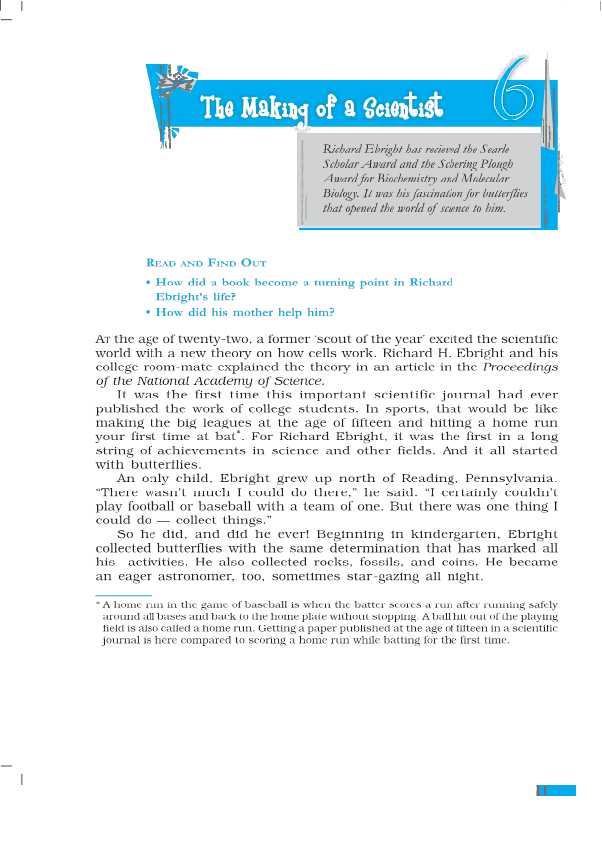
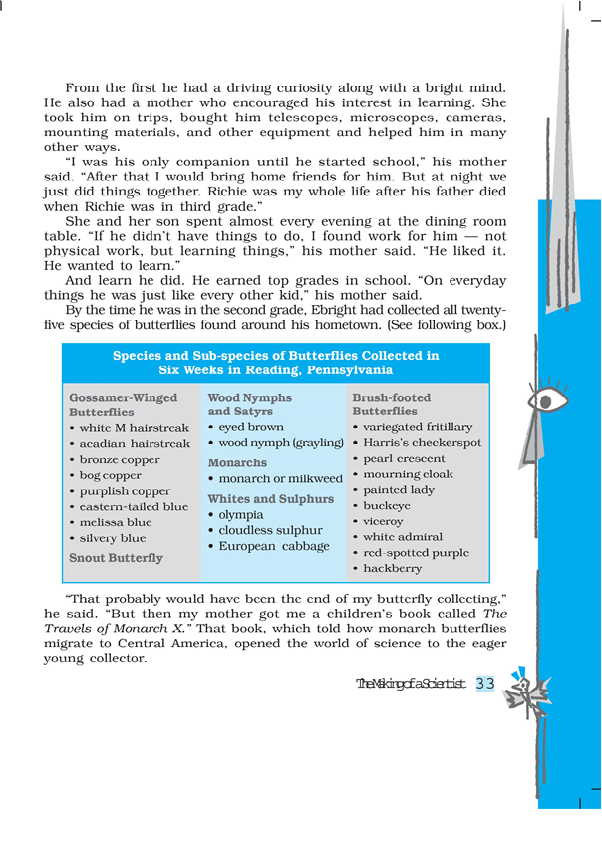
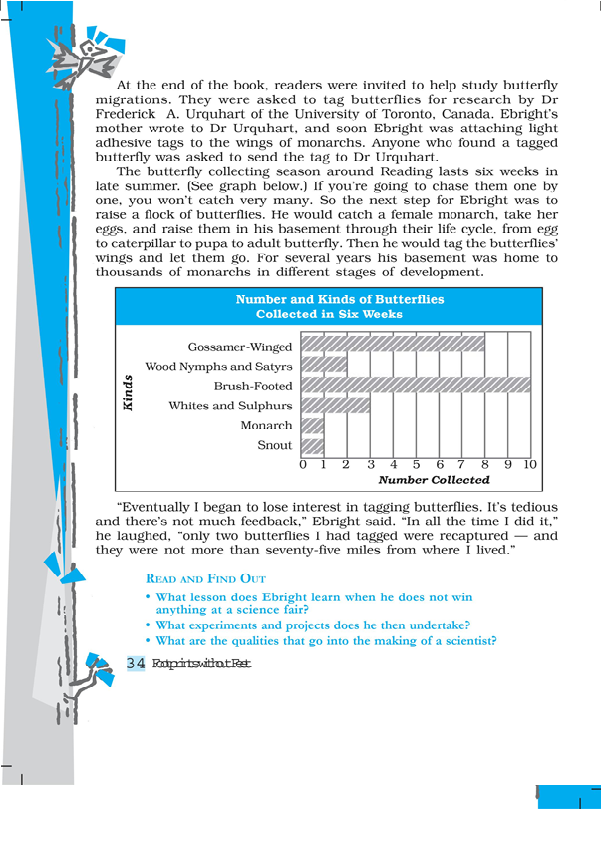
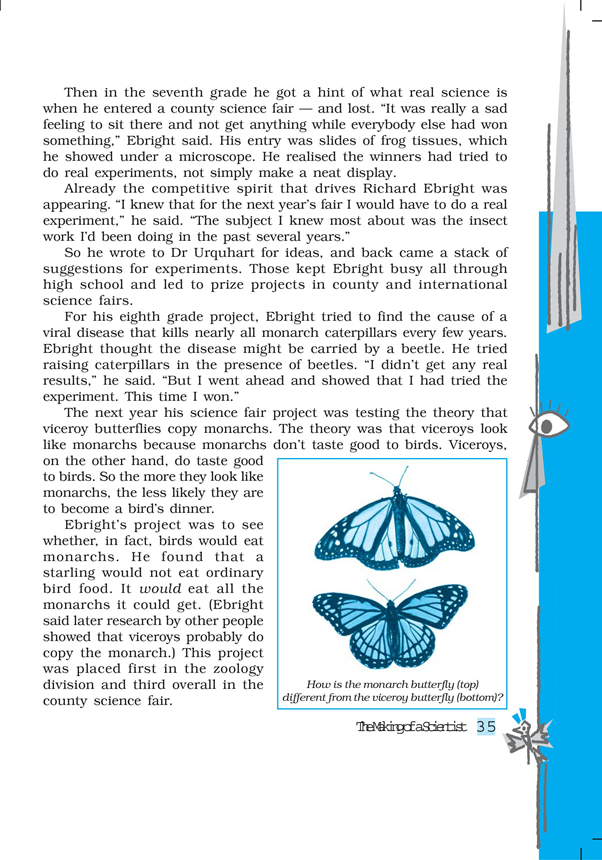
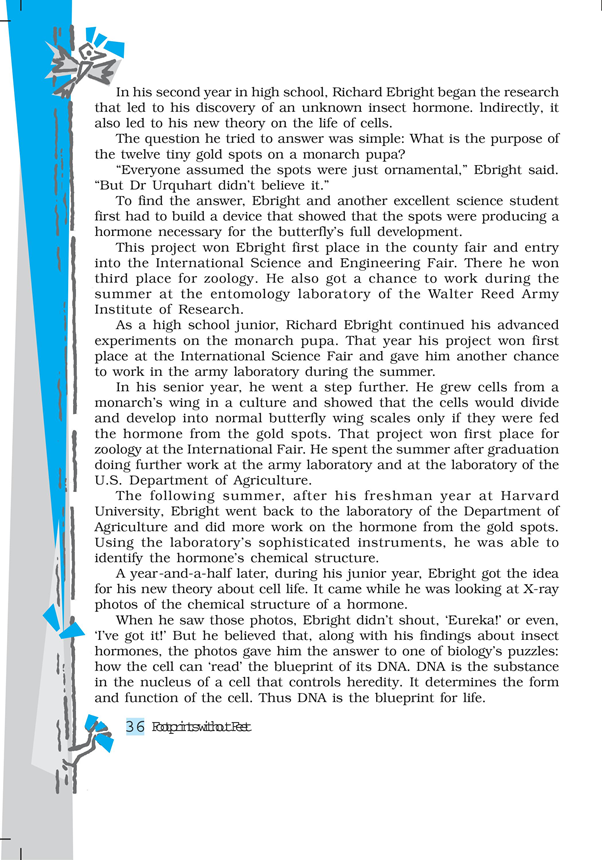
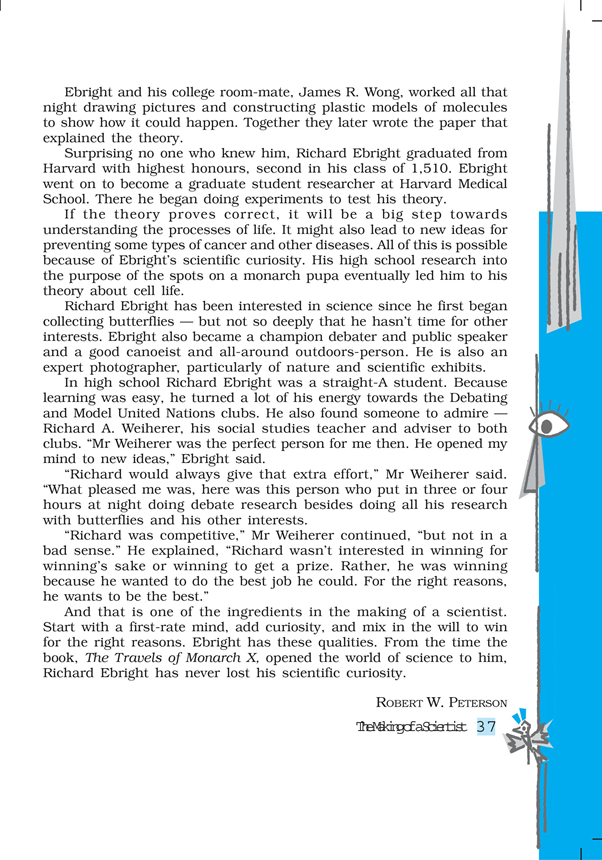
The Making of a Scientist By Robert W Peterson
At the age of twenty-two, a former ‘scout of the year’ excited the scientific world with a new theory on how cells work. Richard H. Ebright and his college room-mate explained the theory in an article in the Proceedings of the National Academy of Science.
It was the first time this important scientific journal had ever published the work of college students. In sports, that would be like making the big leagues at the age of fifteen and hitting a home run your first time at bat*. For Richard Ebright, it was the first in a long string of achievements in science and other fields. And it all started with butterflies.
An only child, Ebright grew up north of Reading, Pennsylvania. “There wasn’t much I could do there,” he said. “I certainly couldn’t play football or baseball with a team of one. But there was one thing I could do — collect things.”
So he did, and did he ever! Beginning in kindergarten, Ebright collected butterflies with the same determination that has marked all his activities. He also collected rocks, fossils, and coins. He became an eager astronomer, too, sometimes star-gazing all night.
From the first he had a driving curiosity along with a bright mind. He also had a mother who encouraged his interest in learning. She took him on trips, bought him telescopes, microscopes, cameras, mounting materials, and other equipment and helped him in many other ways.
“I was his only companion until he started school,” his mother said. “After that I would bring home friends for him. But at night we just did things together. Richie was my whole life after his father died when Richie was in third grade.”
She and her son spent almost every evening at the dining room table. “If he didn’t have things to do, I found work for him — not physical work, but learning things,” his mother said. “He liked it. He wanted to learn.”
And learn he did. He earned top grades in school. “On everyday things he was just like every other kid,” his mother said. By the time he was in the second grade, Ebright had collected all twenty five species of butterflies found around his hometown.
“That probably would have been the end of my butterfly collecting,” he said. “But then my mother got me a children’s book called The Travels of Monarch X.” That book, which told how monarch butterflies migrate to Central America, opened the world of science to the eager young collector.
At the end of the book, readers were invited to help study butterfly migrations. They were asked to tag butterflies for research by Dr Frederick A. Urquhart of the University of Toronto, Canada. Ebright’s mother wrote to Dr Urquhart, and soon Ebright was attaching light adhesive tags to the wings of monarchs. Anyone who found a tagged butterfly was asked to send the tag to Dr Urquhart. The butterfly collecting season around Reading lasts six weeks in late summer. If you’re going to chase them one by one, you won’t catch very many. So the next step for Ebright was to raise a flock of butterflies. He would catch a female monarch, take her eggs, and raise them in his basement through their life cycle, from egg to caterpillar to pupa to adult butterfly. Then he would tag the butterflies’ wings and let them go. For several years his basement was home to thousands of monarchs in different stages of development.
“Eventually I began to lose interest in tagging butterflies. It’s tedious and there’s not much feedback,” Ebright said. “In all the time I did it,” he laughed, “only two butterflies I had tagged were recaptured — and they were not more than seventy-five miles from where I lived.”
Then in the seventh grade he got a hint of what real science is when he entered a county science fair — and lost. “It was really a sad feeling to sit there and not get anything while everybody else had won something,” Ebright said. His entry was slides of frog tissues, which he showed under a microscope. He realised the winners had tried to do real experiments, not simply make a neat display.
Already the competitive spirit that drives Richard Ebright was appearing. “I knew that for the next year’s fair I would have to do a real experiment,” he said. “The subject I knew most about was the insect work I’d been doing in the past several years.”
So he wrote to Dr Urquhart for ideas, and back came a stack of suggestions for experiments. Those kept Ebright busy all through high school and led to prize projects in county and international science fairs.
For his eighth grade project, Ebright tried to find the cause of a viral disease that kills nearly all monarch caterpillars every few years. Ebright thought the disease might be carried by a beetle. He tried raising caterpillars in the presence of beetles. “I didn’t get any real results,” he said. “But I went ahead and showed that I had tried the experiment. This time I won.”
The next year his science fair project was testing the theory that viceroy butterflies copy monarchs. The theory was that viceroys look like monarchs because monarchs don’t taste good to birds. Viceroys, on the other hand, do taste good to birds. So the more they look like monarchs, the less likely they are to become a bird’s dinner.
Ebright’s project was to see whether, in fact, birds would eat monarchs. He found that a starling would not eat ordinary bird food. It would eat all the monarchs it could get. (Ebright said later research by other people showed that viceroys probably do copy the monarch.) This project was placed first in the zoology division and third overall in the county science fair.
In his second year in high school, Richard Ebright began the research that led to his discovery of an unknown insect hormone. lndirectly, it also led to his new theory on the life of cells.
The question he tried to answer was simple: What is the purpose of the twelve tiny gold spots on a monarch pupa? “
Everyone assumed the spots were just ornamental,” Ebright said. “But Dr Urquhart didn’t believe it.”
To find the answer, Ebright and another excellent science student first had to build a device that showed that the spots were producing a hormone necessary for the butterfly’s full development.
This project won Ebright first place in the county fair and entry into the International Science and Engineering Fair. There he won third place for zoology. He also got a chance to work during the summer at the entomology laboratory of the Walter Reed Army Institute of Research.
As a high school junior, Richard Ebright continued his advanced experiments on the monarch pupa. That year his project won first place at the International Science Fair and gave him another chance to work in the army laboratory during the summer.
In his senior year, he went a step further. He grew cells from a monarch’s wing in a culture and showed that the cells would divide and develop into normal butterfly wing scales only if they were fed the hormone from the gold spots. That project won first place for zoology at the International Fair. He spent the summer after graduation doing further work at the army laboratory and at the laboratory of the U.S. Department of Agriculture.
The following summer, after his freshman year at Harvard University, Ebright went back to the laboratory of the Department of Agriculture and did more work on the hormone from the gold spots. Using the laboratory’s sophisticated instruments, he was able to identify the hormone’s chemical structure.
A year-and-a-half later, during his junior year, Ebright got the idea for his new theory about cell life. It came while he was looking at X-ray photos of the chemical structure of a hormone.
When he saw those photos, Ebright didn’t shout, ‘Eureka!’ or even, ‘I’ve got it!’ But he believed that, along with his findings about insect hormones, the photos gave him the answer to one of biology’s puzzles: how the cell can ‘read’ the blueprint of its DNA. DNA is the substance in the nucleus of a cell that controls heredity. It determines the form and function of the cell. Thus DNA is the blueprint for life.
Ebright and his college room-mate, James R. Wong, worked all that night drawing pictures and constructing plastic models of molecules to show how it could happen. Together they later wrote the paper that explained the theory.
Surprising no one who knew him, Richard Ebright graduated from Harvard with highest honours, second in his class of 1,510. Ebright went on to become a graduate student researcher at Harvard Medical School. There he began doing experiments to test his theory.
If the theory proves correct, it will be a big step towards understanding the processes of life. It might also lead to new ideas for preventing some types of cancer and other diseases. All of this is possible because of Ebright’s scientific curiosity. His high school research into the purpose of the spots on a monarch pupa eventually led him to his theory about cell life.
Richard Ebright has been interested in science since he first began collecting butterflies — but not so deeply that he hasn’t time for other interests. Ebright also became a champion debater and public speaker and a good canoeist and all-around outdoors-person. He is also an expert photographer, particularly of nature and scientific exhibits.
In high school Richard Ebright was a straight-A student. Because learning was easy, he turned a lot of his energy towards the Debating and Model United Nations clubs. He also found someone to admire — Richard A. Weiherer, his social studies teacher and adviser to both clubs. “Mr Weiherer was the perfect person for me then. He opened my mind to new ideas,” Ebright said. “
Richard would always give that extra effort,” Mr Weiherer said. “What pleased me was, here was this person who put in three or four hours at night doing debate research besides doing all his research with butterflies and his other interests. “
Richard was competitive,” Mr Weiherer continued, “but not in a bad sense.” He explained, “Richard wasn’t interested in winning for winning’s sake or winning to get a prize. Rather, he was winning because he wanted to do the best job he could. For the right reasons, he wants to be the best.”
And that is one of the ingredients in the making of a scientist. Start with a first-rate mind, add curiosity, and mix in the will to win for the right reasons. Ebright has these qualities. From the time the book, The Travels of Monarch X, opened the world of science to him, Richard Ebright has never lost his scientific curiosity.
The Making of a Scientist Summary
Richard Success at Young Age
The article of Richard and his friend was published in the scientific journal ‘Proceedings of the National Academy of Science’. He was only 22 years old at that time. It was the first time that the research work of college students was published. It was a rare honour for Richard.
Richard A- Collector from Childhood
Richard was the only child of his parents. He grew up at reading in Pennsylvania USA. He had no one to play with. So, he started collecting things like rocks, fossils and coins. Gazing at stars and collecting butterflies where his hobbies.
Richard’s Mother- His Companion
Richard’s mother was constantly with him. She encouraged him by taking him on trips and bought him telescopes and other equipment. She found work to challenge him and helped him to learn a lot.
Richard Reads ‘The Travel of Monarch X’
The reading of a children’s book titled ‘The Travels of Monarch X’ inspired him. He became interested in the world of science. The book asked the readers to study butterfly migrations. Richard came in contact with the scientist doctor Urquhart through this book, who influenced him greatly.
Richard Raises Monarch Butterflies
Richard decided to raise butterflies at home to study their migration patterns. He could catch a female monarch and take her eggs. He would watch all the stages of development of the butterfly. Then he would take their wings and free them. He did it for many years and raised thousands of butterflies in the basement of his home.
Richard Enters County Science Fair
Richard displayed his slides of frogs at the country science fair, but he did not win any award. He realised that he needed to carry out real experiments to win an award. He took suggestions from Dr Urquhart. As a result of his many experiments, he won many prizes at the country and international science fairs in the following years.
Richard’s Eighth Grade Project
Richard tried to find the cause of viral fever that killed thousands of monarch butterflies. He thought that a beetle may carry the virus that causes viral fever. Although this was not the case, he still won a prize for his project.
Richard’s Win at County Science Fair
Richard experimented on viceroy butterflies. He tried to prove that viceroys copy monarchs. Viceroys do it to protect themselves from birds as birds don’t eat monarchs. The project won the first prize in the Zoology division and overall third prize in the country science fair.
Richard’s Discovery of a Hormone
Richard was curious to know that the reason behind 12 gold spots on a monarch pupa. He and his friends built a device to prove that the spots were producing a hormone necessary for its full development. The project got him first prize in the country fair. He also entered the International Science and Engineering Fair. He got first prize for zoology in this fair.
Richard Continues his Research on Monarch Pupa
Richard grew cells from the wings of a monarch butterfly. He further proved that cells grow in scales of wings only when they are injected with the hormone from the gold spots. He carried on his work at the Army laboratory and laboratory of the US Department of Agriculture. After his freshman year at Harvard, he returned to the laboratory of the Department of Agriculture to identify the chemical structure of hormone. This gave him a new idea about cell life.
Richard’s Study of Cell and DNA
Richard’s research on the hormone gave him an idea. He believed that his study could tell how cells read their DNA. He, along with his college roommate, James R Wong, worked on the idea. Then they wrote a paper explaining their theory.
Richard’s Glory at Harvard
Richard graduated with second position in a class of 1510 students. He became a graduate student researcher. He started experimenting to prove his new theory. His theory may create new ways to prevent some types of cancer and other diseases.
Richard- An All Rounder
Richard was not just a scientist. He was an all rounder. He was a good debater and a public speaker. He was also a photographer and an outdoors person. His social studies teacher praised him for his will to work hard, do his best and win.
Richard a True Scientist
Richard had all true qualities that made him a true scientist. He had curiosity and a first-rate mind. He wanted to win for the right reasons.
Chapter Sketch
The story ’The Making of a Scientist’ is written by Robert W Peterson. It is about the great scientist Richard H Ebright. He had a habit of collecting butterflies, rocks fossils and coins since he was a kid. He started scientific research on the study of butterflies. His curiosity and a will to win for the right reasons made him successful.
About the Characters
Richard H Ebright: He is a brilliant scientist. He is noted for his work on cell and reading of DNA.
Richard’s mother: She is an encouraging mother who supported Richard in every way.
Dr Frederick Urquhart: He is a prominent scientist. He did his research on monarch butterflies. He provided valuable guidance to Richard for his projects.
Richard A Weiherer: He is Richard’s social studies teacher. He helped Richard to become a good debater and a public speaker.
James R Wong: He is a fellow scholar who worked with him on a project.
Chapter Highlights
- Richard’s article on how cells work was published in a science Journal at the age of 22.
- Richard was a single child to his parents and didn’t have friends to play with. So, he became interested in collecting butterflies and various other items.
- His mother bought him all the equipment he needed. She guided him and helped him to learn.
- He read a book ‘The Travels of Monarch X’ which created a love for science in him.
- He raised thousands of monarch butterflies at home over a few years. He tagged them as they grew and freed them to study their migration.
- Richard put up a slide of frogs at the county science fair but did not win any award.
- His defeat inspired him to experiment. He took help from Dr Urquhart to work on various projects.
- He won many awards at the County and International Science Fairs in subsequent years.
- His work on viceroy butterflies got him the first position award in a fair.
- Richard discovered a hormone necessary for the growth of monarch butterfly.
- He worked at the Army laboratory in the US Department of Agriculture laboratory.
- Richard spent a year at Harvard as a freshman before going back to the laboratory discovered the chemical structure of the hormone responsible for the gold spots on the monarch pupa.
- His findings motivated him to study cells and how they read their DNA.
- His theory may help to prevent many kinds of cancers and other diseases.
- He graduated from Harvard with second position among 1510 students.
- His other interests include debating, public speaking and photography.
- Richard’s social studies teacher praises him for his excellent mind, curiosity and a will to win-the essential qualities of a scientist.
Word Meanings
Scout: a member of the scout association
Journal: a newspaper or magazine that deals with a particular subject
Making the big leagues: becoming part of a successful or important group
Kindergarten: school for small children
Fossils: the remains of a prehistoric plant/ animal embedded in rock and preserved in petrified form
Astronomer: a scientific observer of stars and planets
Determination: firmness of purpose
Eager: strongly wanting to do or have something
Star-gazing: looking at the stars
Variegated: having patches, strips or marks of different colours
Crescent: a shape that is curved, wide at its centre and pointed at its two ends like a crescent moon
Migrate: move from one place to another
Curiosity: a desire to know or learn
Species: a group of animals or plants that are similar and can produce young animals or plants
Fritillary: butterfly with orange-brown wings that are chequered with black
Monarch and Viceroy: types of butterflies found in North America
Tedious: boring and too slow or long
Tag: a label attached to someone or something for the purpose of identification or to give other information
Adhesive: able to stick fast to a surface object; sticky
Chase: to hurry after someone or something in order to catch him/her or it
Stack: large number
Starling: a dark brown or black bird that is common in Europe and US
Zoology: the branch of science that involves the study of animals and animal behaviour
Ornamental: showy, decorative
Entomology: a branch of science that deals with the study of insects
Culture: the growing of cells in a specially prepared nutrient medium
Scales: small, thin, horny or bony plates
Sophisticated: developed to a high degree of complexity
Eureka: a cry of joy when one discovers something
Heredity: the passing of characteristics from one generation to the next
Blueprint: a design plan
Hormone: a natural substance that is produced in the body and that influences the way in which body grows or develops
Pupa: an insect that is in the stage of development between larva and adult
Canoeist: person paddling a canoe
Expert: a person who is very skillful in a particular area
Exhibits: things
Competitive: trying to win a contest or be more successful than others
Ingredients: a component part or ingredient of something
Debating: a discussion between people in which they express different opinions about something
Sake: for the purpose of
Questions and Answers
NCERT Solutions
Read and Find Out
1. How did a book become a turning point in Richard Ebright’s life?
Answer: The book ‘The Travels of Monarch X’ opened the world of science for Richard. After reading it he became interested in tracking the migration of butterflies. This interest led him to other projects and inspiration. Finally he became a great scientist.
2. How did his mother help him? or Which book did Ebright’s mother get for him? How did it change his life?
Answer: Richard’s mother proved to be a great help to him. She took him on trips and bought scientific equipment for him. She spent all her time in setting up challenges for him. This helped him to learn a lot. She presented him the book ‘The Travels of Monarch X’. The book changed Richard’s life forever.
3. What lesson does Ebright learn when he does not win anything at a science fair?
Answer: Ebright exhibited slides of frog tissues at a science fair. He did not get any prize. He learnt an important lesson that science is not just about display. It is about projects and experiments. He began conducting experiments from that day onwards.
4. What experiments and projects does he do then undertake?
Answer: He undertook many projects and experiments. He worked on viceroy butterflies to show that they copy monarch butterflies. He studied bright spots on the monarch pupa and discovered a new hormone. Also, he found out how cells read their DNA.
5. What are the qualities that go into the making of a scientist?
Answer: There are three essential qualities that make a scientist. The first is a first-rate mind. The next is the presence of curiosity. Last but not the least, it is the will to do the best and win.
Think About It
1. You must have read about cells and DNA in your science books. Discuss Richard Ebright’s work in the light of what you have studied. If you get an opportunity to work like Richard Ebright on projects and experiments which field would you like to work on and why?
Answer: DNA carry the blueprint of life and heredity. They pass information from one generation to the other.
If I get an opportunity to work like Richard Ebright, I would choose to study about diseases. By studying the DNA, I may find ways and means to cure many diseases.
Talk About It
1. Children everywhere wonder about the world around them. The questions they ask are the beginning of scientific enquiry. Given below are some questions that children in India have asked Prof Yashpal and Dr Rahul Pal as reported in their book, Discovered Questions.
(i) What is DNA fingerprinting? What are its uses?
(ii) How do honey bees identify their own honeycombs?
(iii) Why does rain fall in drops?
Answer:(i) DNA fingerprinting is a forensic technique used to identify individuals by the characteristics of the DNA. It is used in parentage testing. It is also used in criminal investigation to identify a person or to place him at the scene of crime.
(ii) Honey bees have signalling chemicals. They leave trails for fellow honeybees so that they can reach their honeycomb.
(iii) The only solid thing in the air are dust particles. Water vapour uses it as a centre of attraction when it becomes too heavy. Water vapour condenses on the dust particle as a drop and falls on Earth.
Extra Questions
Extract Based Questions
Read the following extracts carefully and choose the correct option.
1. So he did, and did he ever! Beginning in kindergarten, Ebright collected butterflies with same determination that has marked all his activities.
(i) What does ‘he did’ in the extract refer to?
(a) Richard’s habit of collecting money
(b) Richard’s habit of storing water
(c) Richard’s habit of making stories
(d) Richard’s habit of collecting various things
(ii) What else did he collect other than butterflies?
(a) Fossils
(b) Coins
(c) Rocks
(d) All of these
(iii) Find a word from the extract which means ‘resoluteness’
(a) Collected
(b) Determination
(c) Dedication
(d) Marked
(iv) What part of speech is the word ‘Beginning’?
(a) Adjective
(b) Noun
(c) Preposition
(d) Conjunction
Answer: (i) (d) Richard’s habit of collecting various things
(ii) (d) All of these
(iii) (b) Determination
(iv) (b) Noun
2. He would catch a female monarch, take her eggs and raise them in his basement through their life cycle….
(i) Who is ‘he’ in this extract?
(a) James R Wong
(b) Dr Frederick
(c) Richard A Weiherer
(d) Richard Ebright
(ii) Why did he raise butterflies?
(a) To export them to various countries
(b) To sell them
(c) To study their migration patterns
(d) To show them to his friends
(iii) Find the word which has the same meaning as the word ‘rear’ from the extract given above.
(a) Raise
(b) Cycle
(c) Foster
(d) Basement
(iv) What part of speech is ‘them’?
(a) Noun
(b) Verb
(c) Pronoun
(d) Adverb
Answer: (i) (d) Richard Ebright
(ii) (c) To study their migration patterns
(iii) (a) Raise
(iv) (c) Pronoun
3. “It was really a sad feeling to sit there and not get anything while everybody else had won something.”
(i) Who is the speaker of the above lines?
(a) Richard’s mother
(b) Richard Ebright
(c) Dr Frederick
(d) James R Wong
(ii) Where was he competing at?
(a) He was competing at a country science fair
(b) He was competing at county science fair
(c) He was competing at an international science fair
(d) He was competing at a trinity fair
(iii) Find a word from the extract which is the opposite of ‘nobody’.
(a) Everyone
(b) Somebody
(c) Everybody
(d) All
(iv) …….. has the same meaning as ‘gloomy’ from the extract given above.
(a) Bad
(b) Mad
(c) Depressed
(d) Sad.
Answer: (i) (b) Richard Ebright
(ii) (b) He was competing at county science fair
(iii) (c) Everybody
(iv) (d) Sad.
4. If the theory proves correct, it will be a big step towards understanding the processes of life.
(i) What is the theory about?
(a) How humans can read DNA
(b) How cells get to know about the neighbouring cells
(c) How cells treat their DNA
(d) How cells read their DNA
(ii) Who proposed the theory?
(a) James R Wong
(b) Richard Ebright
(c) Dr Frederick
(d) Both a and b
(iii) Which part of speech is ‘life’ as used in the given extract?
(a) Verb
(b) Adverb
(c) Noun
(d) Adjective
(iv) Which word in the extract means the same as ‘move’?
(a) Theory
(b) Step
(c) Processes
(d) Life
Answer: (i) (d) How cells read their DNA
(ii) (d) Both (a) and (b)
(iii) (c) Noun
(iv) (b) Step
Short Questions and Answers
1.What rare achievement did Richard manage at the age of 22?
Answer: Richard had a rare honour at the age of 22. He wrote an article with his friend about it theory of how cells work. The article was published in the scientific journal ‘Proceedings of the National Academy of Science. ‘No one had this achievement at such a young age before him.
2. Richard became a collector at an early age. How?
Answer: Richard was the only child of his parents. He had no company at home to play with. So, he started collecting things in his spare time. He would collect coins, fossils, rocks and butterflies as a hobby. He also had a sharp mind and curiosity to know, so it helped him in his learning.
3. Comment on the role played by Richard’s mother in his success.
or How did Ebright’s mother help him in becoming a scientist?
Answer: Richard’s mother made Richard the centre of her life. She would buy microscopes, telescopes and books for him. She arranged trips for him and would also prepare difficult tasks for him. This helped him to learn a lot.
4. How did ‘The Travels of Monarch X’ prove a turning point in Richard’s life?
Answer: Richard was bored with collecting butterflies. At this time his mother got the book ‘The Travels of Monarch X’ for him. After reading the book, he studied the migration of butterflies which told how monarch butterflies migrated to Central America and it opened the world of science to him.
5. Why do viceroy butterflies copy the monarch butterflies?
Answer: Birds eat viceroy butterflies because they taste good to them, where as monarch butterflies do not taste good to the birds. So the viceroys try to copy the monarchs to protect themselves from the birds. Ebright has placed this project and it was the first in Zoology division.
6. Why did Richard lose interest in tagging butterflies?
Answer: Richard raised thousands of butterflies, tagged them and released them to study their migration. But soon, he lost interest because only two of his tagged butterflies were returned to him and they had travelled only 75 miles.
7. Which project did Richard undertake in the eighth grade?
Answer: Richard undertook the project to find the cause of a viral fever that had killed thousands of butterflies. He thought that a beetle might carry the virus, so he rose caterpillars in the presence of beetles. But he was not able to prove it.
8. Richard’s project on the purpose of that 12 tiny gold spots on a monarch pupa was highly valuable in two ways. List the two ways.
Answer: This project had a huge impact. First, he discovered a hormone that was necessary for the growth of the pupa. Secondly, he got a chance to work at a famous laboratory as he won the first prize in the county fair and entry into the International Science and Engineering Fair.
9. Mention any two of Ebright’s contribution to the world of science.
Answer: Ebright built a device that showed that the spot on butterflies wings produce a hormone that is necessary for the growth of a butterfly. His other important contribution proved to be his study of how cells read their DNA.
10. Mr Weiherer pays a glowing tribute to Richard. What did he say?
Answer: Mr Weiherer was Ebright’s social sudies teacher. He praised him for his brilliant mind, his curiosity and a will to win for the right reason. He also admired Richard for his spirit to do his very best all the time.
11. In addition to science what were the other interests of Richard?
Answer: Apart from science, Richard was a good debater and a public speaker as well as a canoeist and an outdoors person. He loved photography as well. He loved to collect different kinds of things and butterflies.
12.What were the factors which contributed in making Ebright a scientist?
Answer: Three qualities of Ebright which contributed were-a first-rate mind, a sense of curiosity and a will to win for the right reasons. Due to these qualities, he became one of the greatest scientists ever.
13. Hobbies play a very important role in one’s life; elaborate this with reference to “The Making of a Scientist”.
Answer: As there were no one to play with Ebright, his mother encouraged him to learn new things. Richard Ebright started collecting butterflies as a hobby. This led him to research and discover many things. Hence, hobbies play an important role in one’s life.
Long Questions and Answers
1. Richards mother had a great influence on him. Discuss.
or Discuss the role of Ebright’s mother in making him a scientist.
Answer: Richard’s mother played a huge role in making him a great scientist. She would take him on trips to encourage learning. He was a single child. After his father died, his mother made him the focus of her life. She would buy him all kinds of microscopes, telescopes and other equipment. After dinner, she gave him problems to solve. This helped Richard to learn a lot. She was his only companion for a long time. She always tried to give him work that required no physical labour but those works enhanced his learning skill. It was his mother who got him the book ‘The Travels of Monarch X’. This book opened the world of science for Richard. She also wrote to Dr Urquhart to guide her son. The scientist helped Richard and guided him. Thus his mother actually shaped him into an extra-ordinary scientist.
2. Richard Ebright displayed a well-rounded personality. Do you agree? Elucidate in the context of the given text.
Answer: Richard’s genius was obvious by the time he was in his second grade. He managed to collect all 25 species of butterflies around his hometown and classify them. He also loved to collect coins, fossils, and rocks. Science was not his only passion. He was an active member of a school’s oratory club and Model United Nations Club and was an effective debater and a public speaker. He loved photography as well. He was enthusiastic and honest and an outdoors person. Learning was easy for him. So, he found it simple to devote time and energy to many other interests. He became a champion in whatever he did. He believed in the spirit of competition to win. But, he did not wish to defeat others just to win. He wanted to win to do his best. Thus, he displayed a well-rounded personality.



